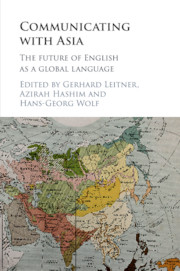Book contents
- Communicating with Asia
- Communicating with Asia
- Copyright page
- Contents
- Figures
- Tables
- Contributors
- Book part
- Communicating with Asia: introduction
- Part I English in selected regional and national habitats with a glance at the role of outward-bound communication needs
- Part II Major other languages in Asia, their international status and impact on education
- 10 Multilingualism, Hindi–Urdu and Indian English: intranational and international diaspora
- 11 Bahasa Indonesia and Bahasa Melayu: convergence and divergence of the official languages in contemporary Southeast Asia
- 12 Putonghua and Cantonese in the Chinese territories
- 13 The Chinese language in the Asian diaspora: a Malaysian experience
- 14 Russian in Far East Asia: linguistic policies on the periphery of empire
- 15 Russian and Turkic languages in Central Asia
- Part III Wider perspectives
- Bibliography
- Index
15 - Russian and Turkic languages in Central Asia
from Part II - Major other languages in Asia, their international status and impact on education
Published online by Cambridge University Press: 05 January 2016
- Communicating with Asia
- Communicating with Asia
- Copyright page
- Contents
- Figures
- Tables
- Contributors
- Book part
- Communicating with Asia: introduction
- Part I English in selected regional and national habitats with a glance at the role of outward-bound communication needs
- Part II Major other languages in Asia, their international status and impact on education
- 10 Multilingualism, Hindi–Urdu and Indian English: intranational and international diaspora
- 11 Bahasa Indonesia and Bahasa Melayu: convergence and divergence of the official languages in contemporary Southeast Asia
- 12 Putonghua and Cantonese in the Chinese territories
- 13 The Chinese language in the Asian diaspora: a Malaysian experience
- 14 Russian in Far East Asia: linguistic policies on the periphery of empire
- 15 Russian and Turkic languages in Central Asia
- Part III Wider perspectives
- Bibliography
- Index
Summary
This chapter discusses the sociolinguistic situation in the Central Asian republics of the former Soviet Union, namely, Kazakhstan, Kyrgyzstan, Uzbekistan and Turkmenistan, with their official languages belonging to the Turkic family. The policy of nationalization that was taken by the new independent states has led to a considerable reduction of bilingualism that was characteristic of the Soviet republics, with a decrease in the role of the Russian language, though it is still the major means for intercultural communication, acquiring information in the domains of politics, economics, science, technology and culture and obtaining jobs in Russia. A new type of bilingualism based on English is observed, geared towards raising the national elite. In some countries, Turkish is also gradually gaining weight.
- Type
- Chapter
- Information
- Communicating with AsiaThe Future of English as a Global Language, pp. 231 - 246Publisher: Cambridge University PressPrint publication year: 2016

